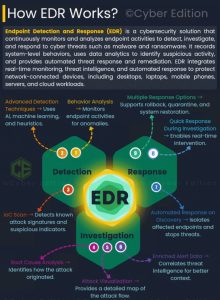Hu for All, that image appears to be an infographic or presentation slide explaining how Endpoint Detection and Response (EDR) works in cybersecurity.
1. **EDR Overview**: EDR is a cybersecurity solution that continuously monitors and analyzes endpoint activities to detect, investigate, and respond to threats like malware and ransomware. It records system behaviors, uses data analytics for identifying suspicious activities, and provides automated responses.
2. **Advanced De tection Techniques**: EDR employs AI, machine learning, and heuristics to detect threats.
tection Techniques**: EDR employs AI, machine learning, and heuristics to detect threats.
3. **Behavior Analysis**: It monitors endpoint activities for anomalies that could indicate potential threats.
4. **Multiple Response Options**: EDR supports various response actions such as rollback, quarantine, and system restoration.
5. **Quick Response During Investigation**: It enables real-time intervention to mitigate threats quickly.
6. **IoC Scan**: EDR detects known attack signatures and suspicious indicators of compromise (IoC).
7. **Automated Response on Discovery**: It isolates affected endpoints and stops threats automatically upon detection.
8. **Enriched Alert Data**: EDR correlates threat intelligence to provide better context for alerts.
9. **Root Cause Analysis**: It identifies the origin of the attack to understand how it occurred.
10. **Attack Visualization**: EDR provides a detailed map of the attack flow, helping in understanding the attack’s progression.
The slide also includes numbered steps (1-6) and terms like “Detection,” “Response,” “Investigation,” and “EDR,” which likely correspond to different stages or components of the EDR process. The numbers 4, 5, and 6 are repeated, possibly indicating a loop or iterative process in the EDR workflow.